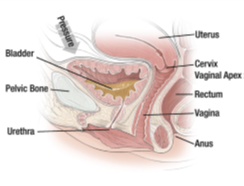Stress Urinary Incontinence in Women (SUI)
You’re not alone if you experience problems like urine leakage when you exercise, sneeze, or laugh. In fact, 1 in 3 adult women have stress urinary incontinence (SUI), which is the most common type of bladder control problem among women. SUI, however, is not just a normal part of aging. Even though you may feel too embarrassed to talk to your doctor, you may have a common, treatable problem. The “stress” is added pressure on your bladder. Women with SUI have weak pelvic muscles that can allow the involuntary loss of urine to leak with a simple cough, sneeze, laugh, or other action that puts pressure on the bladder.
Causes of SUI
While stress urinary incontinence is more common as women age, it is not caused simply by aging. A number of factors put a woman at risk for SUI, including:

- Pregnancy and childbirth, which can stretch, weaken, or even damage pelvic floor muscles
- Neurological conditions that cause damage to the nerves including multiple sclerosis, spina bifida and spinal cord injuries
- Obesity
- Chronic cough, oftentimes caused by smoking
- Certain medications, excessive alcohol consumption and caffeine
- Menopause, due to decreased hormones
- Pelvic surgery or radiation treatment
Symptoms Of Stress Urinary Incontinence
Common symptoms of SUI in women include:
- Urine leaks when you cough, laugh, sneeze, exercise, lift heavy objects, etc.
- Urine leakage worsens when your bladder is full
Stress urinary incontinence, the most prevalent form of incontinence among women, affects an estimated 15 million adult women in the U.S.
Diagnosis
The best way to find a solution to your urinary incontinence problem is to speak to a specialist. As a first step to diagnosing your bladder control problem, your physician will take a comprehensive medical history and perform a physical evaluation to accurately diagnose the condition to prescribe the best treatment option for you. Your doctor may also order additional tests, including urinalysis, and blood work.
Other diagnostic tests may include:
- Stress test: Looks for leaking urine when you cough, laugh, or put other types of pressure on your bladder.
- Post void residual test (PVR): Determines how well you empty your bladder by measuring residual urine after voiding using ultrasound.
- Cystoscopy: A tiny instrument called a cystoscope is inserted into the urethra to find and/or remove abnormalities.
- Urodynamic tests: Diagnostic tests that evaluate the function of the bladder and urethra and include uroflow, cystometrogram, EMG, pressure flow study, or video-urodynamics.
- Bladder diary: You may be asked to keep a record of what you drink, your urine output, when leakage occurs, and what you were doing (coughing, laughing, exercising, etc.) when urine leakage occurred.
